
In 2007 K-1 introduces ongoing Title matches in new Super Heavyweight (over 100kg/220lbs) and Heavyweight (70kg/154lbs - 100kg/220lbs) divisions. At year's end, Semmy Schilt of Holland wears the Super Heavyweight Belt; while Moroccan Badr Hari has the Heavyweight Belt. In World Max action, Dutch fighter Andy Souwer beats Buakaw Por.Pramuk to capture K-1's under 70kg/154lbs Championship for the second time. In the HERO'S mixed martial arts format series, Brazilian J.Z. Calvan repeats as Middleweight Championship with a victory over Andre Dida.
The K-1 World Grand Prix '07 Regional Champions are Mighty Mo in the USA; Paul Slowinski in Europe; and Yusuke Fujimoto in Asia. Doug Viney upsets the favorites to take the Las Vegas Repechage Tournament. At the Yokohama Arena Final on December 8, Dutch fighter Semmy Schilt beats compatriot Peter Aerts to capture the World GP Championship for the third consecutive year.

In 2006, Paul Slowinski of Australia wins the Oceania GP Tournament in Auckland, K-1's first major event in New Zealand; Chalid Die Faust of Germany emerges victorious in the USA GP in Las Vegas; Yasuke Fujimoto wins the Asia GP in Seoul; and Bjorn Bregy of Switzerland is the best on the night in Amsterdam to take the Europe GP.
In World Max action, Buakaw Por Pramuk of Thailand becomes the first two-time Champion; while in K-1's mixed martial arts format Hero's Series, Yoshihiro Akiyama wins in the Light Heavyweight Championship, and JZ Calvin of Brazil takes the Middleweight Belt.
Some 54,800 are on hand at the Tokyo Dome to watch Semmy Schilt defend his World Grand Prix Championship. The Dutchman dispatches veterans Jerome LeBanner, Ernesto Hoost and Peter Aerts en route to victory in a Final that would be broadcast in more than 120 countries.
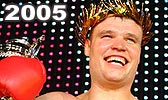
K-1's popularity rockets in South Korea, as the gargantuan Hong-Man Choi beats three fighters (including defending
Asia Champ Kaoklai Kaennorsing) to win the K-1 Asian GP in Seoul. Brazilian Glaube Feitosa emerges best in the Americas,
winning the USA Grand Prix in Las Vegas in impressive style; and in Paris, Semmy Schilt of the Netherlands powers his
way to victory at the European Grand Prix.
Successful Fighting Network events are held round the globe -- more than 10,000 fans fill the Globen Arena in Stockholm for the Scandinavian Tournament. Meanwhile, in World Max action, Andy Souwer of the Netherlands takes the Crown; while in K-1's mixed martial arts format Hero's Series, Norifumi "Kid" Yamamoto wins the Final in front of 53,025 at Osaka Dome on New Year's Eve.
The year's main event, the World GP Final, attracts a sellout crowd of 58,213 to the Tokyo Dome and is broadcast in more than 90 countries. And for the tenth time in K-1's 13-year history a Dutch fighter is victorious, as Schilt stays perfect -- beating Ray Sefo, Remy Bonjasky and Glaube Feitosa to earn fightsports' most coveted crown.
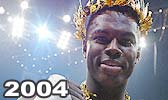
K-1 makes its first foray into Korea, and the sellout crowd sees Thai fighter Kaoklai Kaennorsing win the
first K-1 Asian GP. In World Max action, another Thai fighter, Buakaw Por Pramuk stuns the opposition to
take the crown. Mighty Mo is a surprise winner at the Battle at the Bellagio III, and the slugger represents
the US at the Tokyo Dome World GP Final. There, Japanese Seidokaikan fighter Musashi makes it to the last bout
for the second year running, but Remy Bonjasky is better once again, and repeats as Champion. Dutch fighters
have now won nine of the twelve K-1 World GP Championships.

Masato beats Kraus in the World Max Final and is crowned the first Japanese K-1 Champion. The emergence of
Battle at the Bellagio winner Carter Williams of the United States and Muay Thai fighter Remy Bonjasky of
the Netherlands heralds the arrival K-1's new generation. With a flashy style featuring flying knees and
kicks, the 27 year-old Bonjasky outclasses the competition to take the K-1 World Grand Prix Championship
at the Tokyo Dome.
2002
K-1 introduces its World Max Series, which has a 70kg weight class, and the Dutch fighter Albert Kraus
is crowned the first World Max Champion. In the World GP Series, big Bob "The Beast" Sapp of the United
States stuns the K-1 world by beating Ernesto Hoost twice. But an injury stops Sapp at the Tokyo Dome Final,
and Hoost goes on to win it all and become K-1's first-ever four-time World Grand Prix Champion.
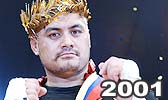
Mark Hunt, a hard-punching 27 year-old New Zealander, comes into the Tokyo Dome Final as an underdog, but
defeats veterans Jerome LeBanner, Stefan Leko and Francisco Filho on a super Saturday to pull the biggest
upset in K-1 history and become the sport's first non-European World Grand Prix Champion.

The new millennium and K-1 sees unprecedented expansion and popularity in Europe and the Americas. At the
Tokyo Dome Final, yet another sellout crowd watches as Dutch fighter Ernesto Hoost successfully defends his
World Grand Prix Championship.
In the 21st Century, Ernesto Hoost repeats as Champion in 2000, and K-1 crowns its first ever Champion from Oceania, New Zealand's Mark Hunt, in 2001. Again, in 2002, Ernesto Hoost wins to become the only four-time Champion. The emergence of American powerhouse Bob Sapp sets the tone for an exciting 2003. Visit the Events page for details on all the action from these years, and for a complete schedule of upcoming K-1 events worldwide.

K-1 has its most successful year yet, with sold-out tournaments including the "K-1 All-Stars" nights and
"K-1 Spirits" series taking the action to fans throughout Japan. The year is capped at another sold-out
Tokyo Dome Grand Prix when Ernesto Hoost, the man they call "Mr. Perfect," wins a thrilling final against
Mirko "Crocop" Filipovic to capture the K-1 Championship.
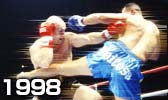
The Swiss event is renamed the K-1 European Grand Prix, with winner Stefan Lefko earning a berth in the
December K-1 Grand Prix at Tokyo Dome. Similarly, Rick Roufus grabs a GP spot by winning the new K-1 USA
Grand Prix, held in August at the Mirage Hotel in Las Vegas. In the Japan GP, held the same month, it is
Satake who advances to the Tokyo Dome Grand Prix Finals, which attract 63, 800 fans and are won by Peter
Aerts, K-1's first three-time champion.

K-1 fighters like Hug, Bernardo, and Aerts are now major celebrities in Japan, appearing on television
and being mobbed by fans in the street. Hug's Fight Night is broadcast on Swiss national television.
In Japan, K-1 holds events in the domed stadiums of the country's three largest cities, Nagoya, Osaka,
and Tokyo. More than 45,000 tickets for the Tokyo Dome Grand Prix sell out in less than an hour. This
year, Ernesto Hoost defeats Hug by decision to capture the crown. Television ratings for the tournament
hit a surprisingly high 20% viewer share. K-1 is now the hottest sport in Japan.
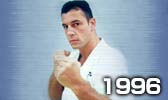
Newcomer Mike Bernardo upsets Aerts in the K-1 Grand Prix, then loses in the final to Hug, who takes a bigger
Fight Night production back to Switzerland this year. In August, a K-1 video game is released for the Sony
PlayStation platform, while in October the nation-wide Fuji TV Network broadcasts the Yokohama Arena K-1 Star
Wars event. This marks the beginning of Fuji's association with K-1.

Aerts successfully defends his title at the 3rd K-1 Grand Prix in May. The following month, Hug's
native Switzerland hosts K-1 Fight Night, the rapidly growing sport's first overseas event. More than
12,000 people watch favorite Hug win by knockout over WKA USA Champion Dennis Lane.
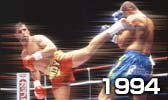
Peter Aerts wins the second K-1 Grand Prix, with newcomer Andy Hug loosing in his first match. In September,
Hug wins a 'revenge' bout at the Yokohama arena, and establishes himself as one of K-1's first superstars.

With karate moving closer to kickboxing in style, Ishii organizes the first K-1 Grand Prix at the Yoyogi
Dai-Ichi Stadium in Tokyo. The event is held in a regulation-size boxing ring under the revolutionary K-1
rules, which permit punches to accommodate both karate and kickboxing fighters. A sellout crowd of 10,000
sees Branco Citatic win the first K-1 Championship. Two more K-1 events are held later in the year, and
these are won by Satake and Ernesto Hoost.
1992
The first glove karate event in Japan, the "Karate Japan Open," is held, and Satake wins it.
1991
Following a series of successful tournaments, Seido Kaikan comes to Tokyo for a tournament against
USA Oyama Karate, in which Satake beats the legendary Willie Williams.
1988
Two of Ishii's students, Toshiyuki Yanagisawa and Masaaki Satake, finish 1st and 2nd in the Karate
Real Champion Tournament, earning Ishii's Seido Kaikan respect in the martial arts community.
1985
Seido Kaikan opens an office in the United States with Tom Edwards as its manager.
1983
Seido Kaikan fighters square off against a group of Kung fu experts at the Queen Elizabeth Stadium in
Kansai and win the contest. Meanwhile, Ishii becomes the first Chairman of the newly formed "All Japan
Budo (Martial Arts) Promotion Association," an organization made up of Kansai-area karate and kenpo
groups.
1982
The first All Japan Karate-Do Tournament is held in Osaka, organized by Ishii and Seido Kaikan, the
new governing body for Seidokan Karate. The full-contact competition fills the Furitsu Gymnasium and
is broadcast on local television.
1980
Kazuyoshi Ishii establishes the Seidokan Karate school in Osaka, with dojos and university-based
karate clubs in the Kansai area.


